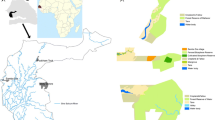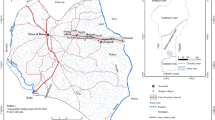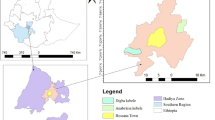Abstract
In the sub-humid part of Burkina Faso, population growth, migrations and new marketing opportunities have induced rapid land-use changes and social reorganization, leading to new approaches to natural resource management. The objective of this study was to evaluate tree biodiversity parameters in agroforestry parklands (scattered trees in crop land) as population increases and fallows become shorter. Out of about 100 tree species existing in the area, and 50 commonly found in traditional parklands, only 3 indigenous and 2 non-native species hold a significant importance for farmers, all for their fruits. No indigenous tree species are planted, but a few are protected when clearing the land. Planted cashew nut orchards develop rapidly and are seen as a land tenure guarantee and an important source of income. Given these facts, the perspectives for tree biodiversity management in farmers’ land may appear bleak. Yet, the importance given by farmers to specific tree products demonstrates that trees do play a part in land development and farmers’ strategies. Existing practices of farmers show potential for improved land-use and spatial patterning of the land, as revealed by emerging parklands and orchards. Our data do not confirm common statements that migrant farmers do not manage the land as sustainably as native farmers do. Rather than trying to conserve tree biodiversity as it is, researchers and developers should identify with farmers the complementarities between trees and farms and promote tree biodiversity through existing practices.
Similar content being viewed by others
References
X. Augusseau E. Liehoun A. Kara (2000) Evolution de l’organisation agraire dans deux terroirs d’accueil de migrants du Sud-Ouest du Burkina Faso Forum National de la Recherche Scientifique et des Innovations Technologiques CNRST, OuagadougouBurkina Faso
Augusseau X., Liehoun E. and Cheylan J.P. 2003. Dynamiques sociales et transformation des espaces. Le cas d’un village burkinabè en pleine recomposition. In: Dugué P. and Jouve Ph. (eds), Organisation spatiale et gestion des ressources et des territoires ruraux. Actes du Colloque International, Montpellier, France25–27 février 2003, UMR SAGERT (CIRAD-CNEARC-ENGREF), Montpellier, Francepp. 254–264.
M.M. Backes (2001) ArticleTitleThe role of indigenous trees for the conservation of bio-cultural diversity in traditional agroforestry land use systems: the Bungoma case study. In-situ conservation of indigenous tree species Agrofor. Syst. 52 119–132 Occurrence Handle10.1023/A:1010685317405
J. Bayala Z. Teklehaimanot S.J. Ouedraogo (2002) ArticleTitleMillet production under pruned tree crowns in a parkland system in Burkina Faso Agrofor. Syst. 54 203–214 Occurrence Handle10.1023/A:1016058906682
Begon M., Harper J.L. and Townsend C.R. 1990. Ecology: Individuals, Populations and Communities (2nd edn). Blackwell Scientific Publications, 945 pp.
Boffa J.M. 1995. Productivity and Management of Agroforestry Parklands in the Sudan Zone of Burkina Faso. Ph.D. Thesis, Purdue University, West Lafayette, Indiana, USA.
Botoni E. 2003. Interactions élevage-environnement. Dynamique du paysage et évolution des pratiques pastorales dans les fronts pionniers du Sud-Ouest du Burkina Faso. Ph.D. Thesis, Montpellier III University, France.
Depommier D. 1996. Structuredynamique et fonctionnement des parcs à Faidherbia albida (del.) A. Chev. Caractérisation et incidence des facteurs biophysiques et anthropiques sur l’aménagement et le devenir des parcs de Dossi et de WatinomaBurkina Faso. Ph.D. Thesis, Pierre & Marie Curie University, Paris, France, 2 vols.
Ducommun G., Cecchini H., Ouedraogo S. and Bengaly A. 2004. La commercialisation vivrière paysanne au Burkina Faso. HESAZollikofen, Université de Sciences Appliquées, BerneSuisse and CEDRES, Université de OuagadougouBurkina Faso. Projet de recherche TASIM AO, Burkina Faso: Série Documents de travail No. 6, 68 pp. http://www.shl.bfh.ch/fef/feprojektef/htm.
P. Dugué F.R. Koné G. Koné (2003) ArticleTitleGestion des ressources naturelles et évolution des systèmes de production agricole des savanes de Côte d’Ivoire: conséquences pour l’élaboration des politiques agricoles Cah. Agric. 12 267–273
A. Ernoult F. Bureau I. Poudevigne (2003) ArticleTitlePatterns of organisation in changing landscapes: implications for the management of biodiversity Landscape Ecol. 18 239–251 Occurrence Handle10.1023/A:1024457031235
B. Finegan R. Nasi (2004) The biodiversity and conservation potential of shifting cultivation landscapes G. Schroth G.A.B. Fonseca Particleda C.A. Harvey C. Gascon H.L. Vasconcelos A.M.N. Izac (Eds) Agroforestry and Biodiversity Conservation of Tropical Landscapes Island Press Washington 153–197
Gazel G. 2002. Des migrants et des arbres. Impact de la population sur la durabilité de l’écosystème au sud ouest du Burkina Faso: cas de Torokoro. M.Sc. Thesis, Creteil Parix XII University/CIRAD, France and CIRDES, Burkina Faso, 48 pp + annex.
L.C. Gray (1999) ArticleTitleIs land being degraded? A multi-scale investigation of landscape change in southwestern Burkina Faso Land Degradation Dev. 10 329–343
Groot A.E. 2002. Demystifying Facilitation of Multi-Actor Learning Process. Ph.D. Thesis, Wageningen University, The Netherlands, 216 pp.
W. Huang O. Luukkanen S. Johanson V. Kaarakka S. Räisänen H. Vihemäki (2002) ArticleTitleAgroforestry for biodiversity conservation of nature reserves: functional group identification and analysis Agrofor. Syst. 55 65–72 Occurrence Handle10.1023/A:1020284225155
R. Joffre S. Rambal J.P. Ratte (1999) ArticleTitleThe dehesa system of southern Spain and Portugal as a natural ecosystem mimic Agrofor. Syst. 45 57–79 Occurrence Handle10.1023/A:1006259402496
R.R.B. Leakey Z. Tchoundjeu R.I. Smith R.C. Munro JM. Fondoun J. Kengue P.O. Anegbeh A.R. Atangana A.N. Waruhiu E. Asaah C. Usoro V. Ukafor (2004) ArticleTitleEvidence that subsistence farmers have domesticated indigenous fruits (Dacryodes edulis and Irvingia gabonensis) in Cameroon and Nigeria Agrofor. Syst. 60 101–111
B.A. Melbourne K.F. Davies C.R. Margules D.B. Lindenmayer D.A. Saunders C. Wissel K. Henle (2004) ArticleTitleSpecies survival in fragmented landscapes: where to from here? Biodiv. Conserv. 13 275–284
O. Mertz (2002) ArticleTitleThe relationship between length of fallow and crop yields in shifting cultivation: a rethinking Agrofor. Syst. 55 149–159 Occurrence Handle10.1023/A:1020507631848
J.P. Metzger (2002) ArticleTitleLandscape dynamics and equilibrium in areas of slash-and-burn agriculture with short and long fallow period (Bragantina region, NE Brazilian Amazon) Landscape Ecol. 17 419–431 Occurrence Handle10.1023/A:1021250306481
Nikiéma P. 2004. Establishment and Indigenous Management of Vitellaria paradoxa Gaerth F. Parkland Systems in Southwestern Part of Burkina Faso: A Case Study of Torokoro Village. M.Sc. Thesis in Agroforestry. Kwame Nkrumah University of Science and Technology, Kumasi, Ghana, 91 pp.
P. Opdam J. Verboom R. Pouwels (2003) ArticleTitleLandscape cohesion: an index for the conservation potential of landscapes for biodiversity Landscape Ecol. 18 113–126 Occurrence Handle10.1023/A:1024429715253
S. Petit (2003) ArticleTitleParklands with fodder trees: a Fulbe response to environmental and social changes Appl. Geogr. 23 205–225 Occurrence Handle10.1016/j.apgeog.2003.08.008
J. Pretty I. Guijt J. Thompson I. Scoones (1995) A Trainer's Guide for Participatory Learning and Action London IIED
A.J. Simons R.R.B. Leakey (2004) ArticleTitleTree domestication in tropical agroforestry Agrofor. Syst. 61 167–181
O. Soemarwoto (1987) Homegardens: a traditional agroforestry system with a promising future H.A. Steppler P.K.R. Nair (Eds) Agroforestry, a Decade of Development ICRAF Nairobi 157–170
M. Tiffen M. Mortimore F. Gichuki (1994) More PeopleLess Erosion. Environmental Recovery in Kenya African Center for Technology Studies NairobiKenya 311
A.C. Weibull Ö. Östman Å. Granqvist (2003) ArticleTitleSpecies richness in agroecosystems: the effect of landscapehabitat and farm management Biodiv. Conserv. 12 1335–1355
Author information
Authors and Affiliations
Corresponding author
Rights and permissions
About this article
Cite this article
Augusseau, X., Nikiéma, P. & Torquebiau, E. Tree Biodiversity, Land Dynamics and Farmers’ Strategies on the Agricultural Frontier of Southwestern Burkina Faso. Biodivers Conserv 15, 613–630 (2006). https://doi.org/10.1007/s10531-005-2090-8
Received:
Accepted:
Issue Date:
DOI: https://doi.org/10.1007/s10531-005-2090-8




